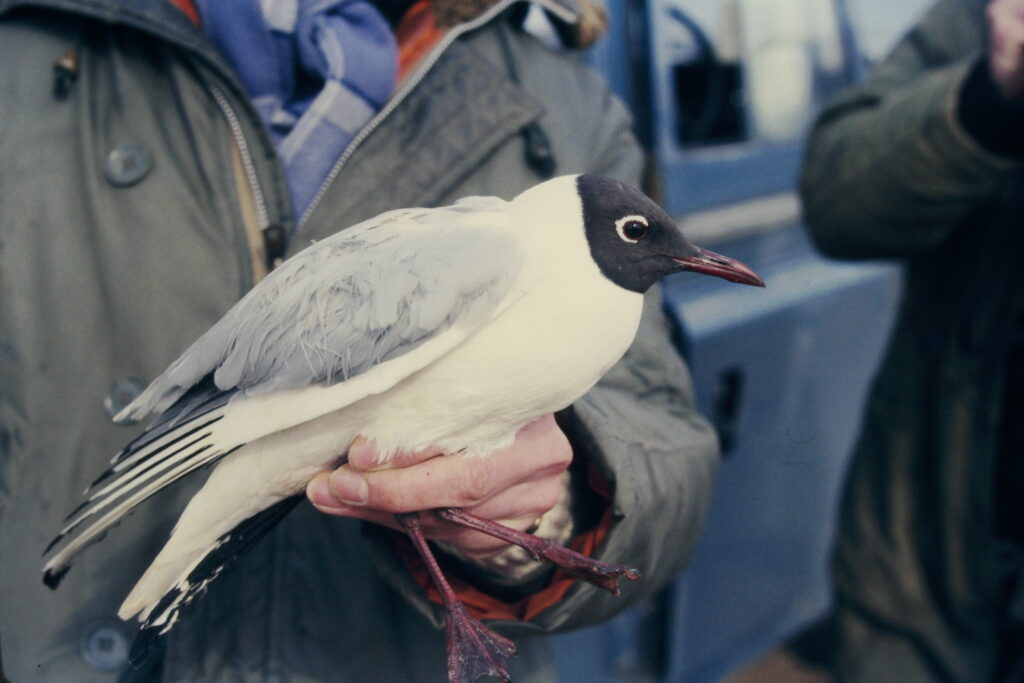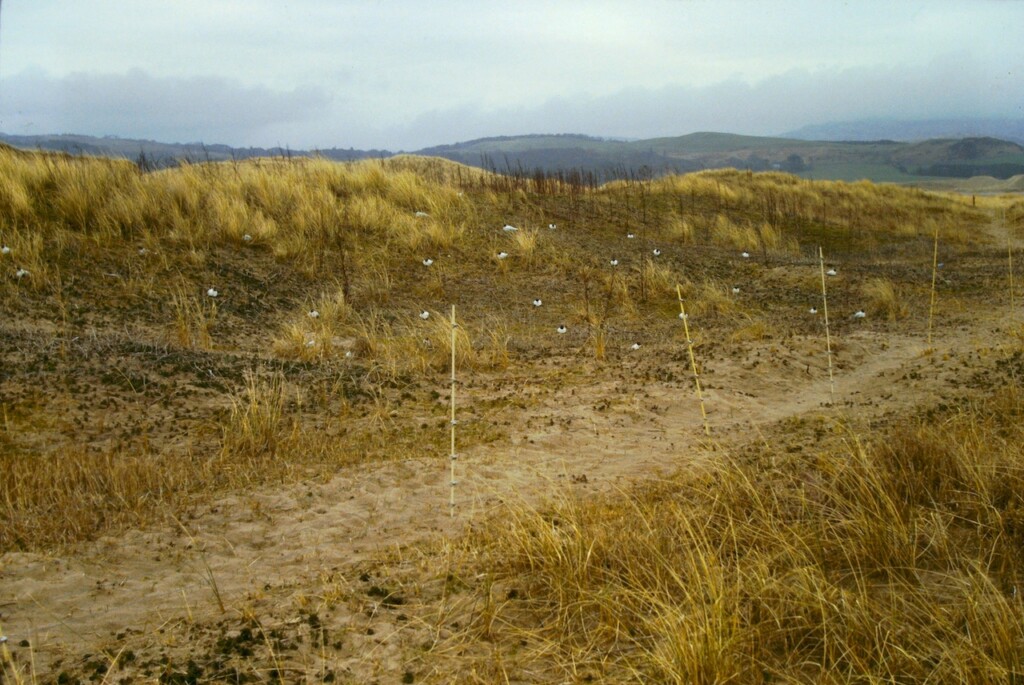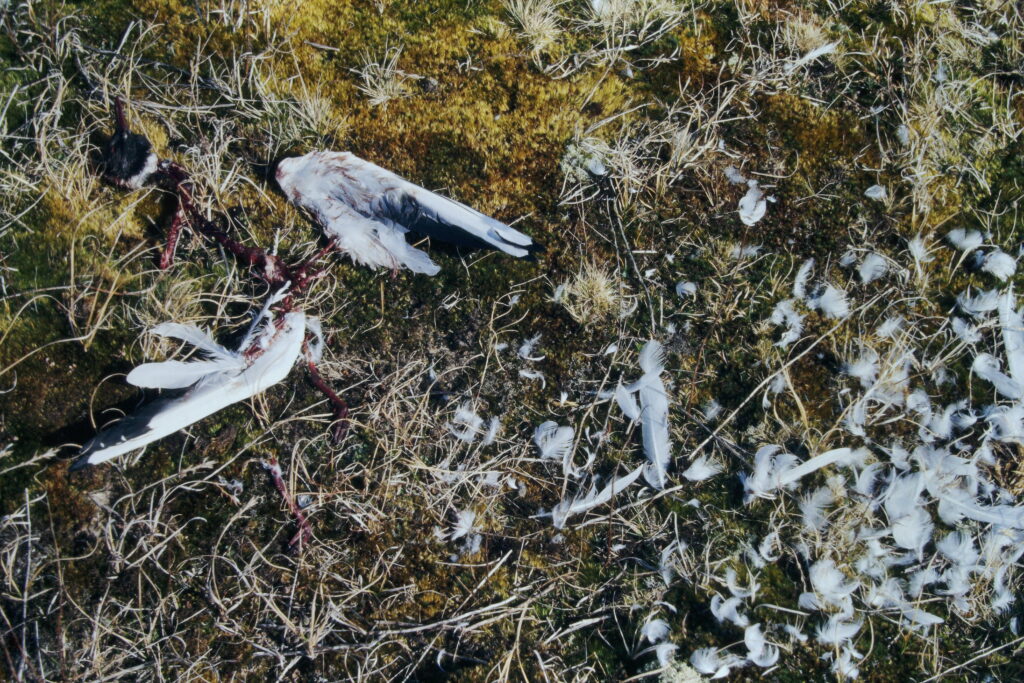Ravenglass peninsula: gulls, foxes, rabbits and public disturbance revisited

Ravenglass estuary and dunes c.1988. Drigg Dunes LNR (including the gullery site) is the large distant dune peninsula, with in the middle distance the smaller dune peninsula of Eskmeals NR. David Simpson
David Simpson wrote “Whatever happened to the Ravenglass gullery?”, published by British Wildlife in February 2001, fifteen years after working as the warden of Drigg Dunes LNR where the gullery had long been present. The article covered the storied history of the Black-headed Gull colony on the remote Cumbrian peninsula and worked to identify the factors which caused its extinction. The gullery was once the largest in the United Kingdom and as recently as 1971 there were over 12,000 pairs alongside 800 pairs of Sandwich Terns and 100 pairs of Common Terns. By summer 1984, all had gone.
At the time of publication, fox predation was identified as the primary driver of decline, with human disturbance noted as significant contributor. More recent research suggests that another historical element is critical to the story of the Ravenglass gullery. Here we share the author’s new findings.
Public disturbance and interference of ground-nesting birds is a serious issue, notably on public sites. Walkers keep adult birds off nests thereby causing eggs and chicks to chill or to be taken by predators. People can also accidently walk or drive on nests. These disturbance effects can be greatly exacerbated by the activities of uncontrolled dogs which may also eat eggs and chicks. Public disturbance can result in areas being avoided by ground-nesting birds or their numbers being restricted. Access control and education is clearly essential if we are to resolve this difficult problem. While reading “Beach nesting Ringed Plovers and their conservation in England” by Liley et al. in BW 33.3 (Dec 2021), the discussion of public disturbance of shore nesting birds and the effects of predators reminded me of my time as warden at Ravenglass (Eskmeals NR & Drigg Dunes LNR) 1983 – 1989. This got me thinking more deeply about the evolution of the Ravenglass gullery population over time and not simply the decline and extinction.
In 2001 BW published my article about the demise of the huge Black-headed Gull colony on the Ravenglass peninsula (BW 12. 3). Although fox predation was identified as the main cause of their extinction in 1984, public disturbance was also a significant factor. Another rather intriguing element which may have played a significant role in the story of the gullery was the rabbit population. When the rabbit population was high it may have absorbed a significant proportion of fox predation thereby sparing a proportion of the gulls and their young.

Durham University ringing group at Ravenglass in 1985. The decline of the Black-headed Gulls at Ravenglass was the subject of a thorough Durham University postgraduate study by Neil Anderson. David Simpson
It’s likely that this remote stretch of coast was historically favourable to nesting gulls, terns and other shorebirds. Gradually rising sea level since the last Ice Age have left evidence of marshland, river channel movement and shingle bars on the current beach and dune area. This evidence shows that there would have been ideal nesting habitat with a measure of protection from disturbance. However, when the peninsula area became permanently joined to the mainland (old maps suggest the late 18th century) the future of ground nesting birds such as gulls and terns would have come under serious threat. Public disturbance and mammalian predation would have increased, although there may have been some level of control on predation and egg collection during this period.
The enclosure of Drigg Common in 1828
Over the last few years I have conducted further research to try to understand the story of the gullery better. I made a breakthrough when I discovered that the date for the enclosure of the common land at Drigg (moorland and dunes) was 1828. The Pennington family had owned the manorial lands of Drigg since c.1597 as part of their Muncaster Estate. Following the enclosure of the common land they managed the Drigg dune peninsula (including the gullery) more closely. Gulls and rabbits would have been carefully protected from predators and gull eggs and rabbits harvested more systematically and sustainably. In addition access to the area was closed to the general public. With tourism and travel in UK increasing towards the end of the 19th century and accelerating in the 20th century, this strictly controlled access would have become important for the stability and growth of the gullery.

Decoy Black-headed Gulls behind an electric fence on a part of the former gullery area in 1987. Despite these efforts which included gullery sound effects, no gulls returned to breed that year. David Simpson
By 1900 and probably since enclosure Muncaster Estate had a watcher-keeper in charge of managing the area including receiving permit only special visitors. These visiting journalists and naturalists referred to an “ancient gullery” which had “vastly increased in numbers”… “under the care and protection of Lord Muncaster” (the Pennington family). The greatly improved fortunes of the gullery would thus appear to be linked to the enclosure of the common land and the resulting changes in management at Drigg earlier in the 19th century. Without such changes this mainland gull colony may have been destined to a much earlier extinction.
Management since 1945
Initial concerns about serious declines in the gullery numbers were reported following the Second World War when over-collecting of gull eggs was undertaken for the war effort, for example three times the number of eggs were collected in 1941 (72,498) compared to just before and after the war. With concerns for the future of the gullery (and associated tern colonies) and the opportunity via the new National Parks and Access to the Countryside Act (1949) to establish the area as a Local Nature Reserve area, the management of the gulleries passed to Cumbria CC in 1954. As a result there was less strict control of public access. This coupled with decreased fox control and the appearance of myxomatosis in the rabbit population during the 1950s, were likely to have been the ‘perfect storm’ that was to eventually see off the gullery for good.
Although there was a revival of the colony in the late 1950s following the cessation of egg collecting, there was a decline in the 1960s. Another revival of the colony in the early 1970s was perhaps by chance immigration of gulls or following Niko Tinbergen’s instigation of fox control after concerns were raised in the 1960s by his Oxford University summer research camp at Ravenglass. However, by the late 1970s the gullery was in terminal decline. Efforts were made by Cumbria CC and the Board of Management to improve the fortunes of the birds by further fox control and greater control of public disturbance. But those efforts were too little and too late. Thus the gullery appears to have been maintained by the management of both human disturbance and fox predation for at least 150 years and finally abandoned the site permanently after the 1984 breeding season when the current management and environmental conditions were insufficient to provide what the birds required to nest safely.

Predated Black-headed Gull, Drigg Dunes LNR c.1985. David Simpson
A future for the gullery?
The gullery has been silent now for 40 years. Sadly it’s not a situation that could easily have been avoided by conservation management. In 1988, four years after the colony last nested, two pairs of Black-headed Gulls and a pair each of Common and Arctic Terns did return to nest on a spit at the tip of the peninsula. Clutches were laid but were soon lost. Fox tracks were found at two nests and high tides were probably also a factor in these losses. Interestingly, this nesting attempt only occurred after reserve monitoring had shown a sustained increase (from a very low ebb) in the rabbit population on the reserve. This suggests that maintaining a healthy rabbit population could encourage the return of both gulls and terns, which along with electric fencing, decoys-sound loops, intensive wardening and possibly limited predator control could help to attract and maintain at least small populations of these birds. Whether this is possible, sustainable and acceptable management is another matter. That year (1988) myxomatosis was first noted on the 9th September and the disease along with rabbit haemorrhagic disease and related viruses will likely have appeared regularly since. 1988 seems to have been the last year that gull or tern nesting attempts were made on the Ravenglass peninsula. However if favourable conditions for nesting gulls and terns were to return at some time in the future, those birds would doubtless soon follow. And if they do return it will be important to have careful monitoring each year of breeding numbers and breeding success as a minimum requirement.
By David Simpson, Bergerac, France, May 2025,
email: audave2505@yahoo.fr
My thanks to Neil Anderson (Durham University Ravenglass gullery research worker
1983 – 87) for reading the original manuscript, comments and encouragement.
